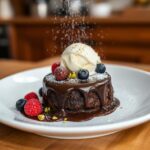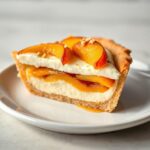There’s something almost magical about the moment you cut into a layered dessert. As the knife glides through each tier, you reveal a beautiful cross-section of colors, textures, and flavors that seem to whisper promises of indulgence. I’ve spent years crafting desserts that not only taste divine but also captivate the eye, and layered desserts have always held a special place in my repertoire. They are as much a feast for the eyes as they are for the palate, and the beauty lies in their versatility—whether you’re aiming for a rustic homemade charm or an elegant showstopper for a grand celebration.
What I love most about layered desserts is how they invite creativity. You can blend contrasting textures—think creamy custard over soft sponge, topped with a whisper of whipped cream—or harmonize flavors, layering chocolate with berries, caramel with banana, or pistachio with rosewater. The layering process itself feels like storytelling; each tier adds a new chapter, and together they form a narrative of pure decadence. This is why, when I talk about layered dessert ideas, I’m not just sharing recipes—I’m passing along techniques, flavor pairings, and presentation secrets that I’ve learned through years of trial, error, and delightful success.
Why Layered Desserts Are Irresistible
The appeal of layered desserts goes beyond the simple fact that they look beautiful. There’s a psychological and sensory satisfaction in experiencing multiple flavors and textures in a single bite. When you sink your fork into a layered trifle, tiramisu, or mille-feuille, your taste buds encounter layers of contrast: the soft sponge balanced by a silky cream, the crunch of nuts against the smoothness of mousse, the tartness of fruit mingling with the sweetness of custard. It’s a symphony of sensations, and that’s something a single-texture dessert rarely delivers.
In my professional kitchen, I’ve often noticed how guests react to layered desserts—they don’t just take a bite and move on; they pause, savor, and often comment on how each mouthful seems slightly different from the last. This is because layered desserts evolve as you eat them. A spoonful that includes more fruit might taste brighter, while one with more chocolate feels richer. That element of surprise keeps people engaged and makes these desserts memorable. And in today’s visual culture, they photograph beautifully, which is why they’re a favorite among both home bakers and pastry chefs aiming to impress.
Essential Ingredients for Perfect Layers
Over the years, I’ve learned that layered desserts are only as good as the ingredients you put into them. The quality of your sponge, cream, fruit, or ganache will directly influence the final result. I always start with the freshest ingredients possible. When I’m making a layered strawberry shortcake, I reach for berries that are ripe but firm, with that deep, sweet aroma you can smell before you even taste them. For chocolate layers, I don’t compromise—I use high-quality chocolate with at least 70% cocoa content when I want a rich, bittersweet depth, or a silky couverture chocolate when I want a smoother, more delicate flavor.
The creams and custards in layered desserts demand just as much attention. A good mascarpone for tiramisu, freshly whipped cream with just enough sugar to balance, or a crème pâtissière made with real vanilla beans can transform a good dessert into a masterpiece. Even the base layers, such as sponge cake, ladyfingers, or shortbread, should be moist yet sturdy enough to hold the structure. One trick I’ve learned is to infuse layers with syrups or liqueurs—not enough to make them soggy, but just enough to enhance flavor and keep the dessert luscious. Small details like this are what separate a professional result from an amateur one.
Must-Have Tools and Equipment
While you can make a layered dessert with little more than a bowl and spoon, having the right tools makes the process more precise, efficient, and satisfying. In my kitchen, I consider certain items indispensable for achieving clean, distinct layers. A good offset spatula is essential for spreading creams evenly without tearing into the layer beneath. A sturdy springform pan or trifle bowl can help maintain shape while the dessert sets, especially for no-bake recipes. For intricate multi-layered creations like opera cake or entremets, an adjustable cake ring is invaluable for keeping layers perfectly aligned.
Another tool I can’t do without is a sharp serrated knife for slicing sponge evenly without compressing it. Piping bags and tips are also incredibly useful—not just for decorative purposes but for adding precise layers of cream or mousse without disturbing the structure. Even something as simple as a long-handled spoon can make it easier to place fruit or other mix-ins exactly where you want them in a tall dessert glass. Investing in a few of these tools doesn’t just make your desserts look better—it makes the process smoother, so you can focus on flavor and presentation rather than wrestling with the mechanics of assembly.
Tips for Creating Stunning Layers
One of the first lessons I learned in pastry school is that precision is everything when it comes to layering. A beautiful layered dessert is the result of patience, control, and an eye for detail. I never rush this process, because every layer deserves its own moment of attention. Start by ensuring your base is completely cool before adding the next layer—whether it’s sponge cake, brownie, or cookie crumble—otherwise, the cream or mousse will melt and lose its structure. I often chill each layer briefly before adding the next, especially when working with whipped cream or ganache, to prevent blending and smudging.
Symmetry matters, too. I always use a ruler or my offset spatula to check that each layer is even, especially in desserts like mille-feuille or opera cake, where visual uniformity makes a huge difference. Flavor contrast is another golden rule—pair something rich with something light, or something sweet with something slightly tart. For example, a dense chocolate cake layer comes alive when topped with raspberry mousse, and a creamy vanilla custard becomes more exciting when paired with a tangy passion fruit jelly. Lastly, I believe in decorating with intention. Garnishes like fresh fruit, chocolate curls, or edible flowers shouldn’t just look pretty—they should complement the flavors within.
Classic Layered Dessert Ideas
There are some layered desserts that I consider timeless—recipes that have stood the test of time because they are universally loved. Tiramisu is one of my personal favorites. The marriage of coffee-soaked ladyfingers, creamy mascarpone, and a dusting of cocoa is simple yet elegant, and with the right quality espresso, it becomes unforgettable. Another classic I adore is trifle, a dessert that invites endless customization. I like to layer sponge cake with custard, whipped cream, and seasonal fruits, sometimes adding a splash of sherry or fruit liqueur for a grown-up twist.
Mille-feuille, or Napoleon, is another masterpiece in the world of layered desserts. Crisp puff pastry alternates with layers of pastry cream, creating a perfect balance of crunch and creaminess. For chocolate lovers, nothing beats a traditional Black Forest cake—rich chocolate sponge layered with cherries and whipped cream, finished with chocolate shavings. These classics are more than just recipes; they’re culinary heritage, and when made with care, they can transport people back to their childhoods or special family gatherings. I always recommend that home bakers master at least one or two of these classics—they’re reliable crowd-pleasers that never go out of style.
Modern & Creative Layered Dessert Twists
While I have great respect for tradition, I also believe that desserts should evolve with our tastes. In recent years, I’ve experimented with layered creations that blend classic techniques with unexpected flavors. For instance, I’ve made matcha tiramisu with green tea-soaked sponge and a light mascarpone cream infused with yuzu. It’s familiar in structure but refreshingly different in taste. Another favorite is my salted caramel and banana mousse parfait, where buttery biscuit crumbs form the base, followed by layers of caramel mousse, sliced bananas, and a final swirl of whipped cream sprinkled with sea salt.
I’ve also explored deconstructed layered desserts served in individual glasses or jars. These not only look modern but also make portion control and serving a breeze. Imagine a layered pistachio and rose panna cotta, with alternating green and pale pink layers, finished with crushed pistachios and edible rose petals. Or a chocolate hazelnut mousse layered with coffee jelly cubes for a sophisticated play on texture. The key with modern twists is to keep the balance between innovation and harmony—you want to surprise people, but never at the expense of flavor or structure.
No-Bake Layered Desserts for Quick Indulgence
As much as I love elaborate baking projects, there are days when I want something indulgent without turning on the oven. That’s where no-bake layered desserts shine. One of my go-to recipes is a no-bake cheesecake trifle. I layer crushed cookies with a tangy cream cheese filling, fresh berries, and a drizzle of fruit compote. It comes together in under an hour but tastes like you’ve been working on it all day. Another easy favorite is chocolate mousse layered with whipped cream and chocolate shavings—a decadent treat that requires minimal effort.
I also enjoy making layered parfaits using yogurt, granola, and fruit for a healthier option that still feels like dessert. For summer gatherings, I’ll prepare a layered icebox cake by alternating graham crackers with whipped cream and fresh fruit, then chilling it until the layers meld into a soft, cake-like texture. The beauty of no-bake desserts is that they allow for spontaneity—you can create something visually stunning and utterly delicious with whatever you have on hand. Plus, they’re perfect for those who are new to layering, since there’s less pressure and fewer technical steps involved.
Healthy Yet Decadent Layered Dessert Options
As a chef, I’ve always believed that dessert should be indulgent, but indulgence doesn’t have to mean heavy or overly sweet. Over the years, I’ve developed layered desserts that feel luxurious but still lean toward the healthier side. One of my favorites is a chia pudding parfait layered with mango purée and coconut yogurt—rich in texture, vibrant in color, and packed with nutrients. Another is a Greek yogurt and berry trifle, where the creaminess of yogurt is paired with a touch of honey, fresh seasonal berries, and a sprinkle of toasted oats for crunch.
When creating healthy layered desserts, I focus on natural sweetness from fruits, a balance of healthy fats, and proteins that satisfy without the sugar crash. Dark chocolate mousse made from avocado and cocoa, layered with almond butter cream, is one such creation that always surprises people with its decadence. Using natural flavor enhancers like vanilla beans, citrus zest, or cinnamon can elevate these lighter desserts, ensuring they’re not just “healthy” but truly crave-worthy. The key is to keep them visually stunning and texturally satisfying so that no one feels like they’re missing out on the real thing.
Festive & Special Occasion Layered Desserts
There’s nothing quite like presenting a layered dessert at a holiday table or special event and seeing everyone’s eyes light up. For festive occasions, I like to go all out—think tall trifles filled with seasonal flavors, such as cranberry and orange for Christmas or tropical mango and passion fruit for summer celebrations. For weddings, I’ve crafted multi-tiered layered cakes with alternating flavors in each tier—vanilla bean sponge with raspberry cream in one, chocolate fudge with salted caramel in another—so guests get a delightful surprise with every slice.
Holidays also invite playful creativity. A pumpkin mousse layered with spiced gingerbread crumbs and whipped cream makes a perfect autumn dessert, while a red velvet trifle layered with cream cheese frosting and strawberries is stunning for Valentine’s Day. The joy of festive layered desserts is that they double as edible centerpieces. They should be bold, colorful, and abundant, sending the clear message that this is a celebration worth savoring.
Make-Ahead & Storage Tips
One of the practical advantages of layered desserts is how well many of them can be prepared ahead of time. I often assemble my trifles, tiramisus, and icebox cakes a day in advance. This not only frees up time on the day of serving but also allows the flavors to meld beautifully. However, timing is everything—too long in advance, and delicate layers might lose their structure. I recommend keeping cream-based desserts refrigerated and covering them well to prevent drying out or absorbing other fridge odors.
When storing leftover layered desserts, I use airtight containers or wrap them tightly with cling film. Some components can be stored separately to maintain freshness; for example, keep crunchy toppings like nuts or cookie crumbles aside until just before serving, so they don’t go soft. Freezing works for certain layered desserts, especially those with sponge and buttercream, but I avoid freezing those with fresh fruit or whipped cream as they tend to weep and lose texture after thawing.
Plating and Presentation Tips for a ‘Wow’ Factor
Presentation is half the magic of a layered dessert. I always say that the first bite is taken with the eyes, and for layered desserts, that means showing off those beautiful stripes of color and texture. Transparent glassware, trifle bowls, or cake stands work wonders for showcasing layers. When serving slices of cake, a hot, clean knife ensures neat edges—wiping between cuts keeps them pristine. Garnishes should be intentional and edible: fresh fruit that reflects the flavors inside, chocolate curls, mint sprigs, or a light dusting of powdered sugar.
Color contrast is another trick I rely on. A pale vanilla mousse looks even more inviting when layered with deep red berries or glossy chocolate ganache. Textural contrast can also be visible—smooth cream next to a crumbly base, or a glossy jelly above a fluffy sponge. Remember, the goal isn’t to overdecorate, but to make the dessert look as irresistible as it tastes.
Common Mistakes to Avoid When Layering Desserts
Even experienced bakers can make missteps with layered desserts. One of the most common errors I see is rushing the cooling process, which causes creams to melt into sponges or mousses to lose their structure. Patience is non-negotiable. Another mistake is using overly wet fillings that seep into the layers, resulting in a soggy dessert. I always test my fruit fillings and custards for consistency before assembly.
Layer proportion is another pitfall—too much of one component can overpower the others. The beauty of layering lies in balance, so each element should shine without dominating the whole. Lastly, I’ve seen people skip tasting each component before assembling. Every layer should be flavorful on its own so that when combined, the dessert is harmonious rather than bland.
Serving Suggestions & Pairings
Pairing your layered dessert with the right accompaniment can elevate the entire experience. A rich chocolate mousse cake, for example, pairs beautifully with a shot of espresso or a glass of ruby port. Fruity layered desserts like lemon trifle or berry pavlova benefit from a crisp sparkling wine or a refreshing mint tea. I also enjoy serving small portions of intensely rich layered desserts alongside something lighter, such as fresh fruit salad, to create a balanced ending to a meal.
Temperature is another factor to consider—some layered desserts are best served chilled, like panna cotta parfaits, while others shine at room temperature, such as layered sponge cakes with buttercream. Serving at the optimal temperature allows flavors to bloom and textures to be enjoyed at their best.
Conclusion & Final Inspiration
Layered desserts are more than just sweet treats—they’re edible works of art. They offer endless opportunities for creativity, from flavor combinations to textures, colors, and presentation styles. Over the years, I’ve found that the most memorable layered desserts aren’t necessarily the most complicated—they’re the ones where every element is made with care and assembled with intention. Whether you’re crafting a simple no-bake parfait for a quick indulgence or an elaborate multi-tiered cake for a special celebration, the joy is in both the making and the sharing.
So the next time you’re in the kitchen, think in layers. Build your dessert like a story, with each tier adding its own flavor, texture, and beauty to the final masterpiece. Trust me—once you start layering, you’ll never look at dessert the same way again.
FAQs on Decadent Layered Desserts
What’s the easiest layered dessert for beginners?
A trifle or no-bake cheesecake parfait is a great starting point—minimal technical skill required, but maximum visual and flavor impact.
How do I keep my layers from blending together?
Chill each layer before adding the next, and make sure your fillings are thick enough to hold their shape.
Can I make layered desserts ahead of time?
Absolutely—just be mindful of ingredients that may weep or lose texture, like fresh berries or whipped cream.
What’s the secret to a professional-looking layered dessert?
Even layers, balanced flavors, and thoughtful garnishes. The little details make the biggest difference.



